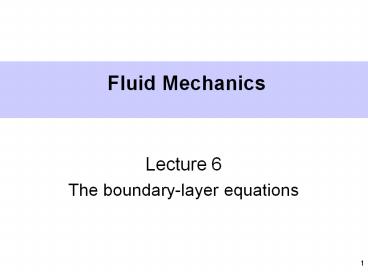Fluid Mechanics - PowerPoint PPT Presentation
1 / 18
Title:
Fluid Mechanics
Description:
Fluid Mechanics Lecture 6 The boundary-layer equations The need for the boundary-layer model While the flow past a streamlined body may be well described by the ... – PowerPoint PPT presentation
Number of Views:127
Avg rating:3.0/5.0
Title: Fluid Mechanics
1
Fluid Mechanics
- Lecture 6
- The boundary-layer equations
2
The need for the boundary-layer model
- While the flow past a streamlined body may be
well described by the inviscid flow (and even the
potential flow) equations over almost all the
flow region, those equations do not satisfy the
fact that because of finite viscosity of real
fluids the flow velocity at the wall itself
must vanish. - So, we need a flow model that uses the simplest
possible form of the Navier Stokes equation but
which does enable the no-slip condition to be
satisfied. - Such a model was first developed by Ludwig
Prandtl in 1904.
3
Objectives of this lecture
- To explore the simplification of the Navier
Stokes equations to obtain the boundary layer
equations for steady 2D laminar flow. - To understand the assumptions used in deriving
these equations. - To understand the conditions in which the
boundary-layer equations can be used reliably.
4
The governing equations
- Navier-Stokes equations
- We seek to simplify these equations by neglecting
terms which are less important under particular
circumstances. - Key assumptions the thickness of the region
where viscous effects are significant,d, is very
thin , i.e. d ltlt L and ReL gtgt1.
Continuity x-momentum y-momentum
5
Non-dimensionalized form of N-S Equations
- Non-dimensional-ize equations using V?, a
constant (approach) velocity, L ,an overall
dimension i.e. - U U/ V? VV/V? xx/L yy/L
- P???
- ( A question for you)
6
Non-dimensionalized N-S equations
x has a magnitude comparable to L
- Since , .
- Hence we write
x has an order of magnitude of 1.
7
Non-dimensionalized N-S equations
- Since and ,
. - Hence we write y O(d).
- Also we have
y is at least an order of magnitude smaller than
1.
8
Continuity equation
V has to be of order O(d) to satisfy
continuity, i.e..
?No term can be omitted hence the continuity
equation remains as it is, i.e.
9
x-momentum equation
10
x-momentum equation
To make the above equation valid, we must have
ReL has to be large and x-gradients in the
viscous term can be dropped in comparison with
y-gradients. The dimensional form of the equation
thus becomes
11
y-momentum equation
To do an order of magnitude analysis for each
term and estimate the order of magnitude for
12
y-momentum equation
? Hence at most
13
y-momentum equation
?The pressure can be assumed to be constant
across the boundary layer over a flat plate.
Hence the pressure only varies in the x-direction
and the pressure at the wall is equal to that at
the edge of the layer, i.e.
U?
14
Two qualifiers
- If the surface has substantial longitudinal
curvature (?/R gt0.1) - it may not be adequate to
- assume constant pressure across boundary layer.
Then one needs to apply radial equilibrium to
compute P (see Slide 16) - In 3D boundary layers (not covered in this course
but very important in the industrial world) one
needs to be able to work out the presssure
variations in the y-z plane (normal to the mean
flow) to compute the secondary velocities .
15
Summary of assumptions
- Basic assumption
- Derived results
- V is small, i.e.
- Re must be large
- and then only velocity gradients normal to the
wall are significant in the viscous term - The pressure is constant across the boundary
layer (for 2D nearly straight) flows, i.e.
16
Boundary layer equations
- Since disappears, the equations become
of parabolic type which can be solved by knowing
only the inlet and boundary conditions... i.e. no
feedback from downstream back upstream. - Unknowns U and V (P? may be assumed known)
- Boundary conditions
Continuity x-momentum
At wall Free stream Inlet
y 0 U V 0 y d U V? ?U? U(x0,y),
V(x0,y)
L
17
Boundary layer over a curved surface
Pressure gradient across boundary layer
Assume a linear velocity distribution, i.e.
integrating from y0 to d gives
Hence pressure variations across the boundary
layer are negligible when
18
Limitations
- Large Reynolds number, typically Re gt1000
- Boundary-layer approximations inaccurate beyond
the point of separation. - The flow becomes turbulent when Re gt 500,000. In
that case the averaged equations may be
describable by an adapted for of momentum
equation to be treated later. - Applies to boundary layers over surfaces with
large radius of curvature.































